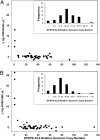Gene amplification confers glyphosate resistance in Amaranthus palmeri
- PMID: 20018685
- PMCID: PMC2824275
- DOI: 10.1073/pnas.0906649107
Gene amplification confers glyphosate resistance in Amaranthus palmeri
Abstract
The herbicide glyphosate became widely used in the United States and other parts of the world after the commercialization of glyphosate-resistant crops. These crops have constitutive overexpression of a glyphosate-insensitive form of the herbicide target site gene, 5-enolpyruvylshikimate-3-phosphate synthase (EPSPS). Increased use of glyphosate over multiple years imposes selective genetic pressure on weed populations. We investigated recently discovered glyphosate-resistant Amaranthus palmeri populations from Georgia, in comparison with normally sensitive populations. EPSPS enzyme activity from resistant and susceptible plants was equally inhibited by glyphosate, which led us to use quantitative PCR to measure relative copy numbers of the EPSPS gene. Genomes of resistant plants contained from 5-fold to more than 160-fold more copies of the EPSPS gene than did genomes of susceptible plants. Quantitative RT-PCR on cDNA revealed that EPSPS expression was positively correlated with genomic EPSPS relative copy number. Immunoblot analyses showed that increased EPSPS protein level also correlated with EPSPS genomic copy number. EPSPS gene amplification was heritable, correlated with resistance in pseudo-F(2) populations, and is proposed to be the molecular basis of glyphosate resistance. FISH revealed that EPSPS genes were present on every chromosome and, therefore, gene amplification was likely not caused by unequal chromosome crossing over. This occurrence of gene amplification as an herbicide resistance mechanism in a naturally occurring weed population is particularly significant because it could threaten the sustainable use of glyphosate-resistant crop technology.
Conflict of interest statement
The authors declare no conflict of interest.
Figures






Comment in
-
Gene amplification delivers glyphosate-resistant weed evolution.Proc Natl Acad Sci U S A. 2010 Jan 19;107(3):955-6. doi: 10.1073/pnas.0913433107. Epub 2010 Jan 11. Proc Natl Acad Sci U S A. 2010. PMID: 20080659 Free PMC article. No abstract available.
Similar articles
-
The unique genomic landscape surrounding the EPSPS gene in glyphosate resistant Amaranthus palmeri: a repetitive path to resistance.BMC Genomics. 2017 Jan 17;18(1):91. doi: 10.1186/s12864-016-3336-4. BMC Genomics. 2017. PMID: 28095770 Free PMC article.
-
EPSPS amplification in glyphosate-resistant spiny amaranth (Amaranthus spinosus): a case of gene transfer via interspecific hybridization from glyphosate-resistant Palmer amaranth (Amaranthus palmeri).Pest Manag Sci. 2014 Dec;70(12):1902-9. doi: 10.1002/ps.3754. Epub 2014 Mar 20. Pest Manag Sci. 2014. PMID: 24497375
-
No fitness cost of glyphosate resistance endowed by massive EPSPS gene amplification in Amaranthus palmeri.Planta. 2014 Apr;239(4):793-801. doi: 10.1007/s00425-013-2022-x. Epub 2014 Jan 3. Planta. 2014. PMID: 24385093
-
Deciphering the Mechanism of Glyphosate Resistance in Amaranthus palmeri by Cytogenomics.Cytogenet Genome Res. 2021;161(12):578-584. doi: 10.1159/000521409. Epub 2022 Jan 12. Cytogenet Genome Res. 2021. PMID: 35021177 Review.
-
Glyphosate Resistance and EPSPS Gene Duplication: Convergent Evolution in Multiple Plant Species.J Hered. 2018 Feb 14;109(2):117-125. doi: 10.1093/jhered/esx087. J Hered. 2018. PMID: 29040588 Review.
Cited by
-
Glyphosate-induced GhAG2 is involved in resistance to salt stress in cotton.Plant Cell Rep. 2022 Apr;41(4):1131-1145. doi: 10.1007/s00299-022-02844-3. Epub 2022 Mar 3. Plant Cell Rep. 2022. PMID: 35243542
-
Genomics for weed science.Curr Genomics. 2010 Mar;11(1):47-51. doi: 10.2174/138920210790217972. Curr Genomics. 2010. PMID: 20808523 Free PMC article.
-
Structural variation of GL1 gene determines the trichome formation in Brassica juncea.Theor Appl Genet. 2023 Mar 23;136(4):75. doi: 10.1007/s00122-023-04301-5. Theor Appl Genet. 2023. PMID: 36952042
-
Biotechnological Road Map for Innovative Weed Management.Front Plant Sci. 2022 Apr 25;13:887723. doi: 10.3389/fpls.2022.887723. eCollection 2022. Front Plant Sci. 2022. PMID: 35548307 Free PMC article. Review.
-
Derived Polymorphic Amplified Cleaved Sequence (dPACS): A Novel PCR-RFLP Procedure for Detecting Known Single Nucleotide and Deletion-Insertion Polymorphisms.Int J Mol Sci. 2019 Jun 29;20(13):3193. doi: 10.3390/ijms20133193. Int J Mol Sci. 2019. PMID: 31261867 Free PMC article.
References
-
- James C. Global status of commercialized biotech/GM crops: 2008. 2008. Available at: www.isaaa.org/resources/publications/briefs/39/executivesummary/default..... Accessed May 7, 2009.
-
- Powles SB. Evolved glyphosate-resistant weeds around the world: Lessons to be learnt. Pest Manag Sci. 2008;64:360–365. - PubMed
-
- Culpepper AS, et al. Glyphosate-resistant Palmer amaranth (Amaranthus palmeri) confirmed in Georgia. Weed Sci. 2006;54:620–626.
-
- Grant WF. Cytogenetic studies in Amaranthus. I. Cytological aspects of sex determination in dioecious species. Can J Bot. 1959;37:413–417.
-
- Webster TM. Weed survey—Southern states. Proc South Weed Sci Soc. 2005;58:291–306.
Publication types
MeSH terms
Substances
Associated data
- Actions
- Actions
- Actions
LinkOut - more resources
Full Text Sources
Other Literature Sources

